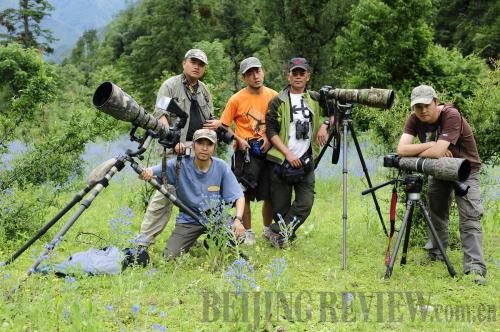|
In addition to the difficulties in finding the animals, there are other challenges as well.
As a man suffering from chronic back problems, Peng endured huge pain during the work. However, it never stopped his passion for this job.
 |
|
IN NATURE: Peng Jiansheng (second right) and Guo Liang (second left) with other members of the IBE survey team in the Meili Snow Mountain in 2009 (XIAOSHIBAI/IBE) |
"It was very cold on the snow mountain and we had to wear a lot of clothes. While we took pictures, we had to kneel down on the ground from time to time. Several days passed and my back hurt badly," said Peng.
Passion, patience and persistence have proven very fruitful.
In November 2010, an IBE survey team finally took a photo of a Red Goral (a small, goat-like animal), a first-class national protected animal of China, in the soft sunset after six days' waiting.
"In addition to patience, to take pictures in nature requires photographers to have sharp eyes," said Peng. "They should be able to catch the animal from a confused mass or a dark environment."
Usually, sharp eyes are ensured by sound biological knowledge. "To catch pictures of the wildlife, we have to know them at first glance," said Guo. "Each IBE photographer is an expert of a certain field, such as insects, beasts and birds."
Guo, a devoted bird photographer, often walks cautiously three or four steps in the wood, stops and looks around, and then squats down for minutes to watch and take photos of the birds.
"To tell the species of a bird, you need to observe its size, action and flying motion. Also, you must carefully observe the colors of its body and feather, and listen to its calls," Guo said.
On the sideline of the survey, the team members also provide training for local residents on the mountain. They encouraged local people to participate in the survey and taught them to take pictures.
The forest rangers patrol the mountain every day. With a tiny camera in hand, they can catch pictures of rare animals. These pictures can be very precious, said Peng.
Peng, together with a group of nature photographers interested in nature conservation, established IBE in 2008. IBE has been devoted to recording, displaying and protecting China's bio-diversity through scientific means.
Previous bio-diversity surveys were dull scientific reports filled with figures, which makes imaging bio-diversity surveys a popular alternative, said Peng.
While traditional biodiversity surveys are based on scientists' observations or specimen collection, IBE surveys focus on recording them through pictures or videos. Each picture has GPS geo-information on it.
Each IBE survey is completed through collaborative work of a well-organized team. The team will consist of photographers and related experts with rich outdoor experience and biology expertise.
So far, IBE has carried out 20 surveys in 11 regions of China. Through these surveys, it has recorded close to 6,500 species, taken 250,000 pictures, and made 1,200 minutes of videos.
"Recording biodiversity through images is not only objective, but also vivid, lively and easy to spread," said Xu Jian, head of IBE. "It can dramatically strengthen the public's understanding of nature. Thus, this is significant for nature protection."
China's biodiversity ranks fifth in the world, but such a precious treasure is not paid enough attention to.
"For some rare species, we don't even have a single picture," said Xu. "In the past three decades of rapid economic development in China, some species have disappeared before we know them, not to mention protecting them."
Image recording is the most fundamental work in this sense. Their works not only have aesthetic value, but also contain rich scientific information and data.
"Only when we know the status of a species, can we be clear about how to protect it," said Xu.
While bringing back survey results to the city, scientists and the media, IBE usually submits a report with suggestions on protecting these species to the local departments of forestry or environmental protection.
In addition to many non-profit projects they conducted to promote biodiversity conservation, IBE also holds nature photography training courses for the public, organizes summer camps for high school students, and recruits volunteers to participate in field investigations.
Email us at: yuyan@bjreview.com | 